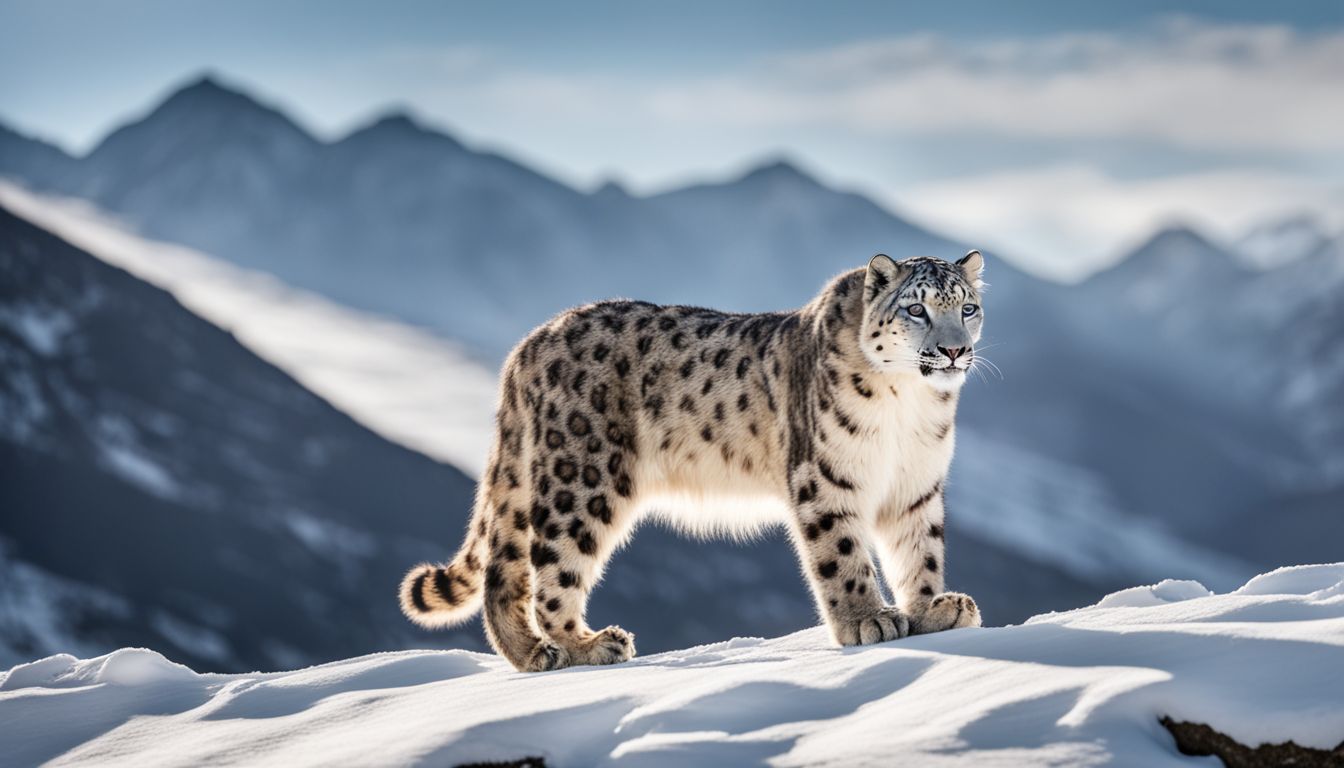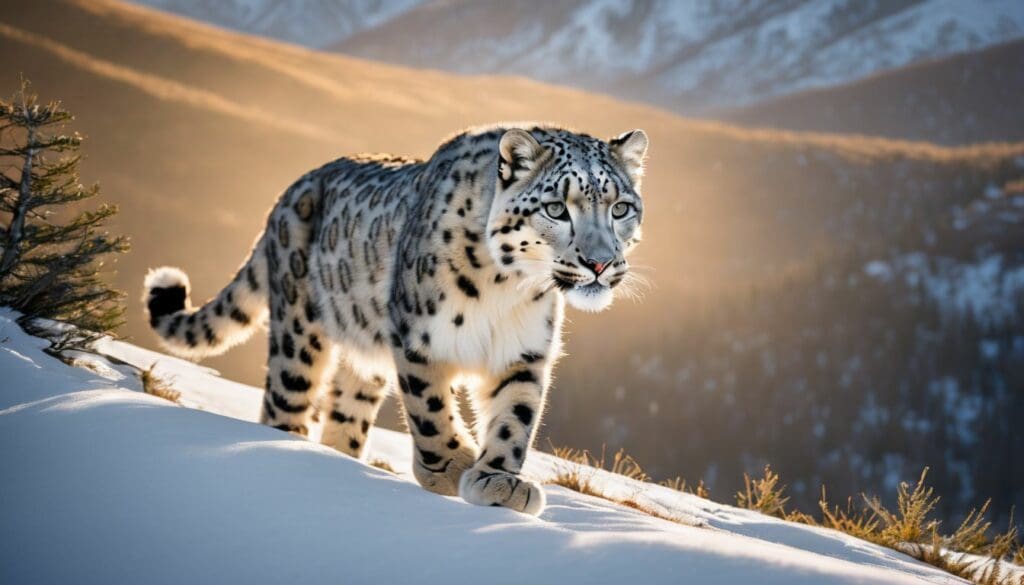The plight of the majestic snow leopard is one that tugs at our heartstrings. These noble creatures are fighting an uphill battle for survival in the wild, where their numbers have dwindled to a mere 4,000 to 6,500 individuals.
Our blog delves into this sobering reality with sensitivity and care, exploring effective strategies and compassionate efforts dedicated to preserving these emblems of mountain serenity.
We invite you to read along and become part of a community intent on safeguarding this irreplaceable jewel of nature.
Key Takeaways
- Snow leopards, with an estimated population of 4,000 to 6,500, are vital apex predators that maintain the health of their mountain ecosystems and prevent overgrazing.
- They face critical threats such as habitat loss due to human expansion, poaching for fur and body parts, climate change impacts reducing prey availability, and conflicts with local farmers.
- Conservation strategies include working with local communities for education and livestock protection measures, partnering with groups like the Snow Leopard Trust for monitoring populations, enforcing anti-poaching laws in areas like Hemis National Park, and promoting eco-friendly tourism.
- New conservation areas are being established to increase safe habitats; global cooperation is sought through UN programmes for adapting to climate changes affecting snow leopards.
- Various initiatives focus on capacity building among wildlife personnel from Himalayan states in conservation methods whilst engaging policymakers towards stronger environmental governance.
The Importance of Snow Leopards in the Ecosystem

We recognise snow leopards as crucial players in maintaining the health of their high-altitude homes. These magnificent big cats act as apex predators, a vital role that keeps prey species like the blue sheep and Himalayan tahr in check.
This balance prevents overgrazing, ensuring vegetation remains intact to protect against erosion and maintain water resources vital for downstream communities.
Our commitment extends beyond admiration; we understand that protecting snow leopards helps safeguard entire ecosystems. Their presence reflects the well-being of countless other species within the same habitat.
Loss of these predators could lead to ecological imbalance, threatening the survival of plants, animals, and humans alike who depend on these mountainous regions for water, food security, and climatic stability.
Major Threats to Snow Leopards and Conservation Challenges

Understanding the crucial role snow leopards play in maintaining ecological balance is just one piece of the puzzle. Protecting them from myriad threats forms a complex and pressing challenge.
Snow leopards face many dangers that threaten their survival, with habitat loss at the forefront. Expanding human activities like agriculture and infrastructure development chip away at their mountainous homes, leaving less space for these majestic animals to roam.
Poaching and illegal wildlife trade also pose significant risks to snow leopard populations. They’re hunted for their beautiful fur and body parts, which are wrongly believed to have medicinal properties.
Climate change exacerbates these problems by altering habitats and reducing prey availability across Central Asia’s highlands. Further complicating conservation efforts are human-wildlife conflicts, where local farmers retaliate against snow leopards preying on livestock due to dwindling wild prey numbers.
Tackling these challenges requires community-based conservation programmes that prioritise sustainable practices while fostering coexistence between humans and this flagship species.
Conservation Efforts and Strategies
We are making progress in the fight to save snow leopards. Our strategies focus on preserving these majestic creatures and their natural habitats.
- We partner with local communities in the Himalayas, involving them directly in conservation projects. This includes educating pastoralists about the importance of snow leopards to the ecosystem and helping them implement livestock protection measures.
- Our teams work closely with wildlife conservation groups like Snow Leopard Trust and WWF to monitor snow leopard populations. Together, we track movement patterns, health status, and breeding success which guide our protection plans.
- Anti-poaching initiatives are critical for safeguarding snow leopards. We train and equip forest guards, employ cutting-edge technology for surveillance, and enforce stricter penalties against poaching activities in protected areas like Hemis National Park.
- We encourage eco – friendly tourism practices in regions like Sikkim and Himachal Pradesh. Ecotourism offers economic benefits to locals while raising awareness about the importance of preserving snow leopard habitats.
- Establishing new conservation areas contributes to increasing the safe territories for snow leopards. Initiatives by Wildlife SOS aim to create corridors that reduce fragmentation of habitats on the Tibetan Plateau.
- Collaborating with international bodies such as United Nations Environment Programme helps us integrate climate change adaptation into our strategies. By understanding changing weather patterns, we minimise vulnerabilities faced by snow leopards due to climate change impacts.
- Habitat restoration is also a priority. Reforestation efforts restore crucial ecological processes that are essential not only for wild species like Capra sibrica but also for maintaining water security.
- Capacity building involves training personnel from various Himalayan states in wildlife management and research methods. Skilled individuals lead conservation tasks more effectively within their local regions.
- Working with policy – makers ensures environmental governance is strengthened across borders where snow leopards roam freely between countries such as Bhutan and Tibet.
Conclusion: The Future of Snow Leopard Conservation
As we tackle the tall task of safeguarding snow leopards, our resolve must never waver. The mountains call us to act swiftly and passionately for these majestic creatures. Their survival hinges on our collective efforts in conservation.
Together, let’s step up, embrace the challenge, and ensure a secure future for the elusive snow leopard amidst a rapidly shifting climate. Through unity and relentless dedication, their silent roars will echo through the ages.
FAQs
1. What is being done to save the endangered snow leopard?
Organisations like WWF and the Snow Leopard Network are working together on conservation efforts, involving local communities and promoting climate adaptation strategies in habitats such as the Great Himalayan National Park.
2. Why are snow leopards threatened?
Snow leopards face threats due to ecological problems, impacts of climate change, competition for food with species like Ovis ammon and Hemitragus jemlahicus, and changes in agricultural productivity which affect their mountain ecosystems.
3. How does climate change affect snow leopards?
The changing climate can lead to loss of habitat for prey animals like Marmota himalayana, which decreases food availability for snow leopards; it also exposes them to more vulnerabilities such as increased human-wildlife conflict.
4. Can community involvement help in conserving snow leopards?
Yes! When local people take part in conservation projects within regions like Khangchendzonga National Park, they help protect the ecology by reducing poaching and unsustainable land use practices that hurt these big cats’ habitats.
5. What role do international bodies play in protecting snow leopards?
International bodies such as UN Environment Programme and International Union for Conservation of Nature provide guidelines for countries to increase their efforts against ecological threats causing vulnerabilities to endangered species including the majestic snow leopard.





